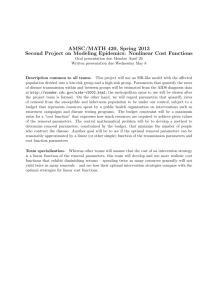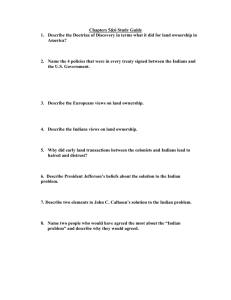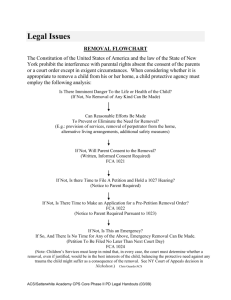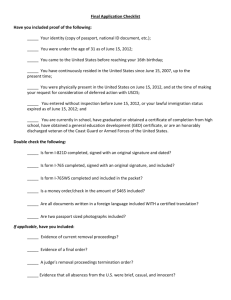The Supreme Court Affirms the Constitutional Validity of the PCAOB
advertisement
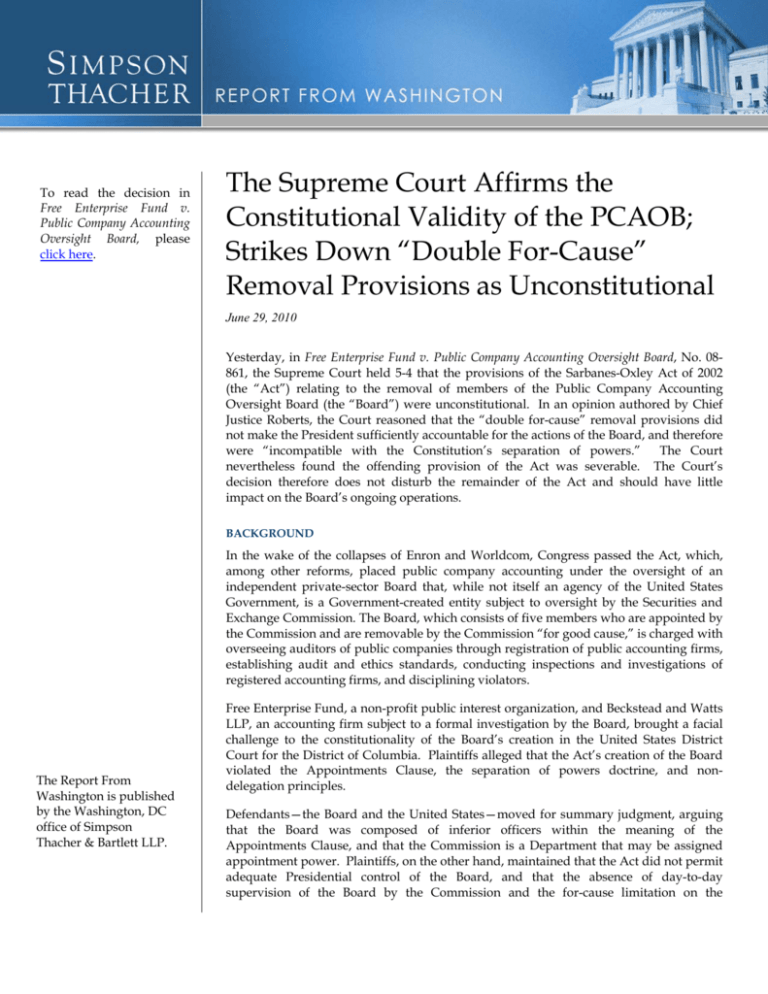
To read the decision in Free Enterprise Fund v. Public Company Accounting Oversight Board, please click here. The Supreme Court Affirms the Constitutional Validity of the PCAOB; Strikes Down “Double For-Cause” Removal Provisions as Unconstitutional June 29, 2010 Yesterday, in Free Enterprise Fund v. Public Company Accounting Oversight Board, No. 08861, the Supreme Court held 5-4 that the provisions of the Sarbanes-Oxley Act of 2002 (the “Act”) relating to the removal of members of the Public Company Accounting Oversight Board (the “Board”) were unconstitutional. In an opinion authored by Chief Justice Roberts, the Court reasoned that the “double for-cause” removal provisions did not make the President sufficiently accountable for the actions of the Board, and therefore were “incompatible with the Constitution’s separation of powers.” The Court nevertheless found the offending provision of the Act was severable. The Court’s decision therefore does not disturb the remainder of the Act and should have little impact on the Board’s ongoing operations. BACKGROUND In the wake of the collapses of Enron and Worldcom, Congress passed the Act, which, among other reforms, placed public company accounting under the oversight of an independent private-sector Board that, while not itself an agency of the United States Government, is a Government-created entity subject to oversight by the Securities and Exchange Commission. The Board, which consists of five members who are appointed by the Commission and are removable by the Commission “for good cause,” is charged with overseeing auditors of public companies through registration of public accounting firms, establishing audit and ethics standards, conducting inspections and investigations of registered accounting firms, and disciplining violators. The Report From Washington is published by the Washington, DC office of Simpson Thacher & Bartlett LLP. Free Enterprise Fund, a non-profit public interest organization, and Beckstead and Watts LLP, an accounting firm subject to a formal investigation by the Board, brought a facial challenge to the constitutionality of the Board’s creation in the United States District Court for the District of Columbia. Plaintiffs alleged that the Act’s creation of the Board violated the Appointments Clause, the separation of powers doctrine, and nondelegation principles. Defendants—the Board and the United States—moved for summary judgment, arguing that the Board was composed of inferior officers within the meaning of the Appointments Clause, and that the Commission is a Department that may be assigned appointment power. Plaintiffs, on the other hand, maintained that the Act did not permit adequate Presidential control of the Board, and that the absence of day-to-day supervision of the Board by the Commission and the for-cause limitation on the Simpson Thacher’s Report From Washington, June 29, 2010 Page 2 Commission’s removal power meant that the Board members were not inferior officers and therefore must be appointed by the President. Agreeing with Defendants, the district court granted their motion. On appeal, the Court of Appeals for the District of Columbia Circuit affirmed the district court’s finding that the Board members were inferior officers. The court found the President’s ability to appoint and remove Commissioners, and the Commissioners’ ability to appoint Board members and remove them for cause, “preserves sufficient Executive influence over the Board through the Commission so as not to render the President unable to perform his constitutional duties.” Free Enter. Fund v. Pub. Co. Accounting Oversight Bd., 537 F.3d 667, 683 (D.C. Cir. 2008). The D.C. Circuit, like the district court, also rejected Plaintiffs’ contentions that, even if Board members are inferior officers, they cannot be appointed by the Commission because the Commission is not a “Department” and the Commissioners are not its “Head” within the meaning of Article II. In a dissenting opinion, Judge Kavanaugh of the D.C. Circuit observed that for-cause removal has long been criticized as inconsistent with the text of the Constitution. Noting that both Commissioners and Board members are only removable for cause, Judge Kavanaugh stated that the Act created a “double for-cause removal provision [that] . . . completely strips the President’s removal power and . . . poses a greater restriction on the President’s constitutional authority than a single for-cause provision.” Free Enter. Fund, 537 F.3d at 701 (Kavanaugh, J., dissenting). SUMMARY OF THE DECISION “By granting the Board executive power without the Executive’s oversight, this Act subverts the President’s ability to ensure that the laws are faithfully executed . . . .” OPINION OF THE COURT “[T]he President . . . cannot hold the Commission fully accountable for the Board’s conduct . . . .” OPINION OF THE COURT In an opinion authored by Chief Justice Roberts, and joined by Justices Scalia, Kennedy, Thomas, and Alito, the Supreme Court held: “By granting the Board executive power without the Executive’s oversight, this Act subverts the President’s ability to ensure that the laws are faithfully executed—as well as the public’s ability to pass judgment on his efforts.” The Court found that “the dual for-cause limitations on the removal of Board members contravene the Constitution’s separation of powers” by compromising the President’s ability to execute the laws. Recognizing that the Court “previously upheld limited restrictions on the President’s removal power,” the Court noted that the “second level of tenure protection changes the nature of the President’s review.” Unless the Commission can remove a Board member at will, “the President . . . cannot hold the Commission fully accountable for the Board’s conduct, to the same extent that he may hold the Commission accountable for everything else that it does.” The Court rejected each of the Government’s arguments in support of the validity of the removal power. First, although the Government argued that the Commission’s removal power is broad, the Court observed that the Government did “not contend that simple disagreement with the Board’s policies or priorities could constitute ‘good cause’ for its removal.” Second, even though the Commission has power over Board functions, “[b]road power over Board functions is not equivalent to the power to remove Board members.” And, finally, the Court was unconvinced that its conclusion is contradicted by past practice of Congress given that the Act “is highly unusual in committing substantial executive authority to officers protected by two lawyers of for-cause removal . . . .” www.simpsonthacher.com Simpson Thacher’s Report From Washington, June 29, 2010 Page 3 Although the Court agreed that the removal provision is unconstitutional, it limited the impact of its opinion by finding “that the unconstitutional tenure provisions are severable from the remainder of the statute.” “Concluding that the removal restrictions are invalid leaves the Board removable by the Commission at will . . . .” Accordingly, the Act “remains ‘fully operative as a law’ with these tenure restrictions excised.” The Act “remains ‘fully operative as a law’ with these tenure restrictions excised.” Justice Breyer authored a dissenting opinion, joined by Justices Stevens, Ginsburg, and Sotomayor, in which he wrote: “in my view the statute does not significantly interfere with the President’s ‘executive Power’ . . . . And the Court’s contrary holding threatens to disrupt severely the fair and efficient administration of the laws.” OPINION OF THE COURT Justice Breyer observed that, historically, “the Court in these circumstances has looked to function and context, and not to bright-line rules.” According to Justice Breyer, such an approach would allow: (1) all three branches “to exercise practical judgment in response to changing conditions and ‘exigencies’”; and (2) “Congress and the President the flexibility needed to adapt statutory law to changing circumstances.” Justice Breyer took note of the fact that the Executive and Legislative Branches were not “divided in their support for the ‘for cause’ provision at issue here,” and urged that “we should decide the constitutional question in light of the provision’s practical functioning in context.” “I still see no way to avoid sweeping hundreds, perhaps thousands of high level government officials within the scope of the Court’s holding, putting their job security and their administrative actions and decisions constitutionally at risk.” JUSTICE BREYER, DISSENTING Justice Breyer also disagreed with the Court’s reasoning on other grounds, noting that the Court’s decision “is both imprecise and overly broad.” First, he concluded that “the ‘for cause’ restriction before us will not restrict presidential power significantly.” Second, he observed that “[t]his Court has long recognized the appropriateness of using ‘for cause’ provisions to protect the personal independence of those who even only sometimes engage in adjudicatory functions” or who “supervise, and are themselves, technical professional experts.” Fourth, Justice Breyer concluded: “[w]here a ‘for cause’ provision is so unlikely to restrict presidential power and so likely to further a legitimate institutional need, precedent strongly supports its constitutionality.” Fifth, Justice Breyer critiqued the Court’s decision “because of considerable uncertainty about the scope of its holding . . . .,” questioning the many other officers who may be impacted by the Court’s decision. Justice Breyer warned: “I still see no way to avoid sweeping hundreds, perhaps thousands of high level government officials within the scope of the Court’s holding, putting their job security and their administrative actions and decisions constitutionally at risk.” Finally, Justice Breyer took issue with the Court’s assuming— rather than deciding —whether Commissioners are themselves protected by a “for cause” requirement. IMPLICATIONS Although the Supreme Court held the Act’s “double for-cause” removal provisions to be unconstitutional, the Court’s decision will likely have only limited impact on the Board’s operations. The Court expressly affirmed the continued validity of the Board, and emphasized that the only change to the Board is that the Commission may now remove Board members at will. While the Commission could, in theory, use this increased ability to remove Board members to ensure that the Board’s agenda more closely follows its own, the Commission is unlikely to take action that could be seen as undermining the Board's independence except in extreme circumstances. www.simpsonthacher.com Simpson Thacher’s Report From Washington, June 29, 2010 Page 4 Separately, it will be interesting to see whether any other significant separation-ofpowers challenges arise in the wake of the Court’s decision, especially given Justice Breyer’s dissent which questioned whether the Court’s decision undermines the legal status of many high-ranking government officials. In its decision, however, the Court consistently stressed that its ruling was based on the particular factual circumstances of this case. This narrow focus suggests that the Court did not intend to open the door to new constitutional challenges to the legitimacy of government officials based on removal provisions. For further information about this decision, please feel free to contact members of the Firm’s Litigation Department, including: New York City: Bruce Angiolillo 212-455-3735 bangiolillo@stblaw.com Lynn Neuner 212-455-2696 lneuner@stblaw.com Michael Chepiga 212-455-2598 mchepiga@stblaw.com Thomas Rice 212-455-3040 trice@stblaw.com Paul Curnin 212-455-2519 pcurnin@stblaw.com George Wang 212-455-2228 gwang@stblaw.com Michael Garvey 212-455-7358 mgarvey@stblaw.com Jonathan Youngwood 212-455-3539 jyoungwood@stblaw.com Paul Gluckow 212-455-2653 pgluckow@stblaw.com Washington DC: David Ichel 212-455-2563 dichel@stblaw.com Peter Kazanoff 212-455-3525 pkazanoff@stblaw.com Linda Martin 212-455-7722 lmartin@stblaw.com Mary Elizabeth McGarry 212-455-2574 mmcgarry@stblaw.com Joseph McLaughlin 212-455-3242 jmclaughlin@stblaw.com Peter Bresnan 202-636-5569 pbresnan@stblaw.com Arman Oruc 202-636-5599 aoruc@stblaw.com Peter Thomas 202-636-5535 pthomas@stblaw.com Palo Alto: Alexis Coll-Very 650-251-5201 acoll-very@stblaw.com James Kreissman 650-251-5080 jkreissman@stblaw.com The contents of this publication are for informational purposes only. Neither this publication nor the lawyers who authored it are rendering legal or other professional advice or opinions on specific facts or matters, nor does the distribution of this publication to any person constitute the establishment of an attorney-client relationship. Simpson Thacher & Bartlett LLP assumes no liability in connection with the use of this publication. www.simpsonthacher.com Simpson Thacher’s Report From Washington, June 29, 2010 Page 5 UNITED STATES ASIA New York Beijing 425 Lexington Avenue New York, NY 10017 212-455-2000 3119 China World Tower One 1 Jianguomenwai Avenue Beijing 100004, China +86-10-5965-2999 Los Angeles 1999 Avenue of the Stars Los Angeles, CA 90067 310-407-7500 Palo Alto 2550 Hanover Street Palo Alto, CA 94304 650-251-5000 Washington, D.C. 1155 F Street, N.W. Washington, D.C. 20004 202-636-5500 EUROPE London CityPoint One Ropemaker Street London EC2Y 9HU England +44-(0)20-7275-6500 Hong Kong ICBC Tower 3 Garden Road Hong Kong +852-2514-7600 Tokyo Ark Mori Building 12-32, Akasaka 1-Chome Minato-Ku, Tokyo 107-6037, Japan +81-3-5562-6200 LATIN AMERICA São Paulo Av. Presidente Juscelino Kubitschek, 1455 São Paulo, SP 04543-011, Brazil +55-11-3546-1000 www.simpsonthacher.com
